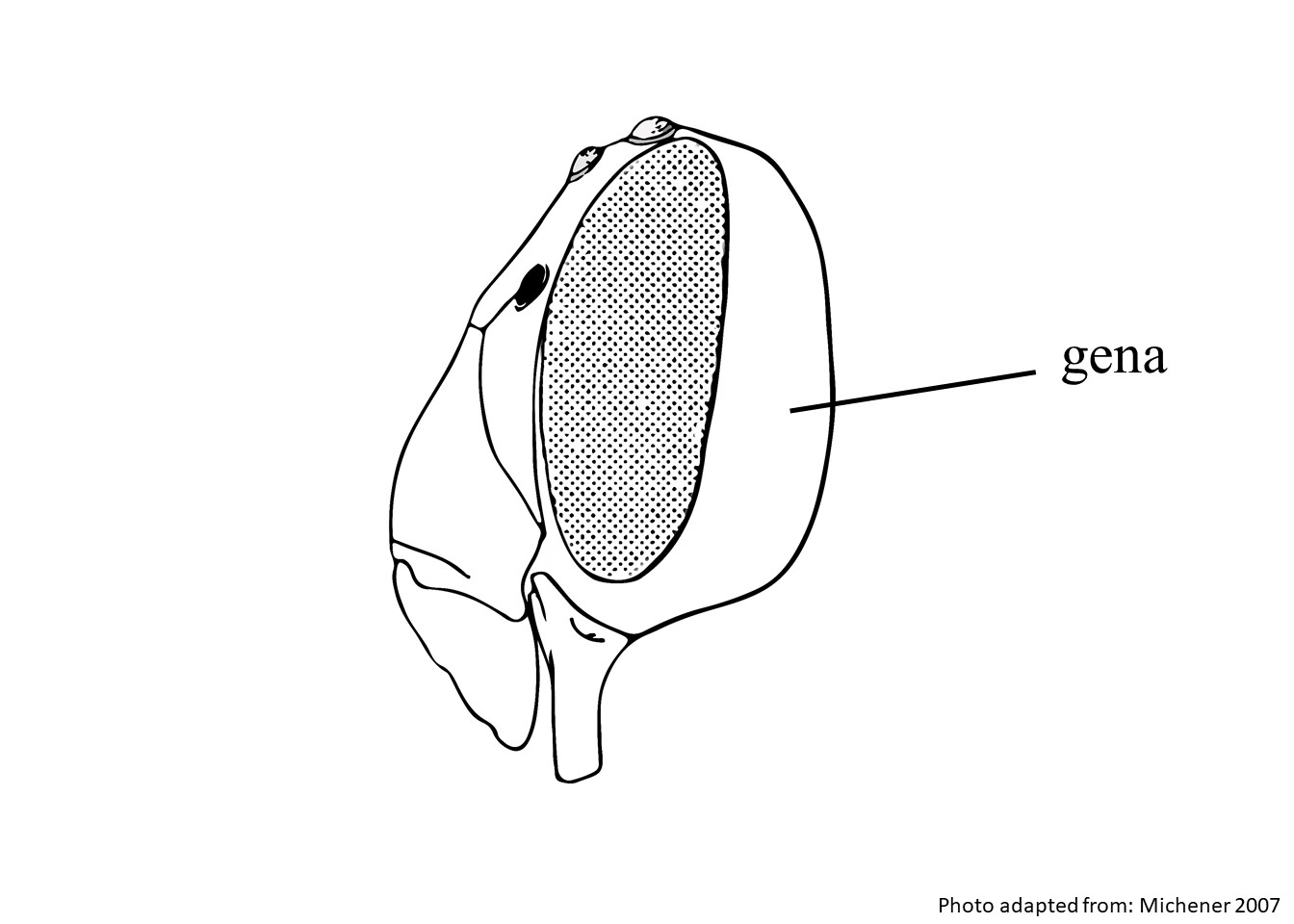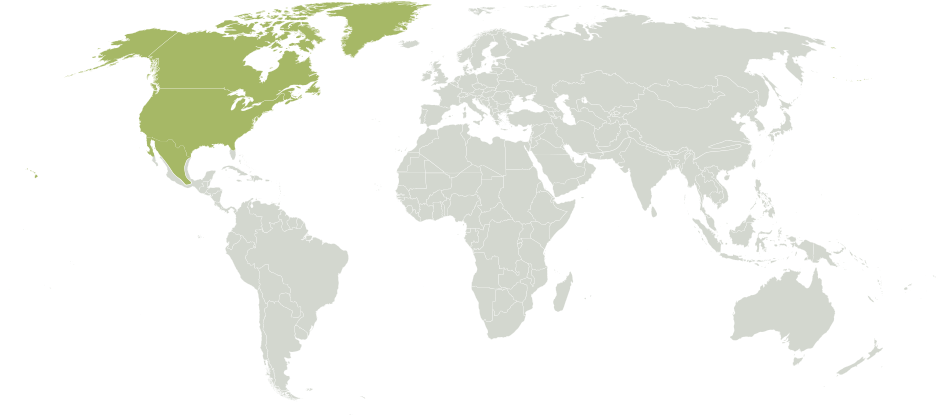Family: Megachilidae
Subfamily: Megachilinae
Tribe: Megachilini
Genus: Megachile Latreille, 1802
Subgenus: Acentron Mitchell, 1934
Common name: none
Megachile (Acentron) albitarsis are black bees with white, yellow, and/or black pubescencepubescence:
short, fine hair
(Mitchell 1943Mitchell 1943:
Mitchell, T.B. 1943. On the classification of neotropical Megachile (Hymenoptera: Megachilidae). Annals of the Entomological Society of America 36: 656-97.). They range in body length from 11–13 mm (Mitchell 1943Mitchell 1943:
Mitchell, T.B. 1943. On the classification of neotropical Megachile (Hymenoptera: Megachilidae). Annals of the Entomological Society of America 36: 656-97.).
(modified from Mitchell 1937aMitchell 1937a:
Mitchell, T.B. 1937. A revision of the genus Megachile in the Nearctic region. Part VI. Taxonomy of the subgenera Argyropile, Leptorachis, Pseudocentron, Acentron, and Melanosarus. Transactions of the American Entomological Society 63: 45-83.; Mitchell 1943Mitchell 1943:
Mitchell, T.B. 1943. On the classification of neotropical Megachile (Hymenoptera: Megachilidae). Annals of the Entomological Society of America 36: 656-97.; Gonzalez et al. 2018Gonzalez et al. 2018:
Gonzalez, V.H., T. Griswold, and M.S. Engel. 2018. South American leaf-cutter bees (genus Megachile ) of the subgenera Rhyssomegachile and Zonomegachile , with two new subgenera (Hymenoptera: Megachilidae). Bulletin of the American Museum of Natural History 2018(425): 1-74.)
 usually broader than the width of the eye in laterallateral:
usually broader than the width of the eye in laterallateral: is mostly hairless on the discdisc:
is mostly hairless on the discdisc: is broadly rounded or apicallyapically:
is broadly rounded or apicallyapically:Female Megachile (Acentron) may be confused with female bees within the subgenus Megachile (Leptorachina) with similar four-toothed mandibles with a small second interspace and mostly bare S6S6:
the plates on the underside of the abdomen, often abbreviated when referring to a specific segment to S1, S2, S3, S4, S5, S6, S7, or S8
 . Female Megachile (Acentron) can be differentiated by the wide genagena:
. Female Megachile (Acentron) can be differentiated by the wide genagena:
the cheek or side of the head and more robust mandiblemandible:
and more robust mandiblemandible:
bee teeth, so to speak, usually crossed and folded in front of the mouth (Gonzalez 2018). Male Megachile (Acentron) are most similar to Megachile (Melanosarus) because they both lack tibial spurs on the middle legs and the modified front and middle tibiatibia:
the segment of the leg, between the femur and the tarsus and tarsitarsi:
the group of segments at the end of the leg following the tibia
. Megachile (Acentron) can be identified by the scutumscutum:
the large segment on top of the thorax located between the wings and behind the head
, which has punctures that are dense enough that the punctures are not individually distinguishable and often by the presence of a spine on the coxacoxa:
the basal segment of the leg of the mid-leg (Gonzalez et al. 2018Gonzalez et al. 2018:
Gonzalez, V.H., T. Griswold, and M.S. Engel. 2018. South American leaf-cutter bees (genus Megachile ) of the subgenera Rhyssomegachile and Zonomegachile , with two new subgenera (Hymenoptera: Megachilidae). Bulletin of the American Museum of Natural History 2018(425): 1-74.).
Megachile (Acentron) albitarsis is a generalist that has been observed visiting a variety of species in different plant families including: Anacardiaceae, Apiaceae, Apocynaceae, Arecaceae, Asteraceae, Eriocaulaceae, Fabaceae, Haemodoraceae, Lamiaceae, Orobanchaceae, Plantaginaceae, Polygonaceae, Rubiaceae, Xyridaceae, and Verbenaceae (Mitchell 1937aMitchell 1937a:
Mitchell, T.B. 1937. A revision of the genus Megachile in the Nearctic region. Part VI. Taxonomy of the subgenera Argyropile, Leptorachis, Pseudocentron, Acentron, and Melanosarus. Transactions of the American Entomological Society 63: 45-83.; Deyrup et al. 2002Deyrup et al. 2002:
Deyrup, M., Edirisinghe, J. and Norden, B. 2002. The diversity and floral hosts of bees at the Archbold Biological Station, Florida (Hymenoptera: Apoidea). Insecta Mundi 16: 87-120, 544.).
Megachile (Acentron) have been found nesting in pre-existing cavities including artificial trap-nests, where they make nest cells using cut leaves (Reyes-Novelo et al. 2009Reyes-Novelo et al. 2009:
Reyes-Novelo, E., V. Meacute;leacute;ndez-Ramiacute;rez, R. Ayala, and H. Delfiacute;n-Gonzaacute;lez. 2009. Bee faunas (Hymenoptera: Apoidea) of six natural protected areas in Yucatan, Mexico. Entomological News 120(5): 530-544.; Hall and Ascher 2010Hall and Ascher 2010:
Hall, H.G. and J.S. Ascher. 2010. Surveys of bees (Hymenoptera: Apoidea: Anthophila) in natural areas of Alachua County in north-central Florida. Florida Entomologist 93(4): 609-629.; Torretta et al. 2017Torretta et al. 2017:
Torretta, J.P., G.A. Molina, and D.A. Aquino. 2017. Life cycles and hostndash;parasitoid relationships of five species of Leucospis wasps in Argentina (Hymenoptera: Leucospidae). Journal of Natural History 51(29-30): 1727-1742.; Santos et al. 2020Santos et al. 2020:
Santos, C.O., P.E.C. Peixoto, and C.M.L. Aguiar. 2020. Cavity length affects the occupation of trap-nests by Centris analis and Tetrapedia diversipes (Hymenoptera: Apidae). Sociobiology 67(2): 261-267.).
Megachile (Acentron) includes eighteen species (Moure et al. 2012Moure et al. 2012:
Moure, J.S., D. Urban, and G.A.R. Melo. 2012. Catalogue of Bees (Hymenoptera, Apoidea) in the Neotropical Region - online version http://www.moure.cria.org.br/catalogue. Accessed Nov/11/2020).
There are no known invasives.
Megachile (Acentron) occurs from the southern U.S. to Argentina, the majority of which are found in the tropics. One species, Megachile (Acentron) albitarsis, is native to the U.S. (Michener 2007Michener 2007:
Michener, C.D. 2007. The Bees of the World (2nd ed.). Johns Hopkins University Press, Baltimore and London, 953 pp.).

Distribution map generated by Discover Life -- click on map for details, credits, and terms of use.
Deyrup, M., J. Edirisinghe, and B. Norden. 2002. The diversity and floral hosts of bees at the Archbold Biological Station, Florida (Hymenoptera: Apoidea). Insecta Mundi 16(1-3): 87-120.
Gonzalez, V.H., T. Griswold, and M.S. Engel. 2018. South American leaf-cutter bees (genus Megachile) of the subgenera Rhyssomegachile and Zonomegachile, with two new subgenera (Hymenoptera: Megachilidae). Bulletin of the American Museum of Natural History 2018(425): 1-74.
Hall, H.G. and J.S. Ascher. 2010. Surveys of bees (Hymenoptera: Apoidea: Anthophila) in natural areas of Alachua County in north-central Florida. Florida Entomologist 93(4): 609-629.
Michener, C.D. 2007. The Bees of the World (2nd ed.). Johns Hopkins University Press, Baltimore and London, 953 pp.
Mitchell, T.B. 1937. A revision of the genus Megachile in the NearcticNearctic:
biogeographical region comprising North America as far south as northern Mexico, together with Greenland region. Part VI. Taxonomy of the subgenera Argyropile, Leptorachis, Pseudocentron, Acentron, and Melanosarus. Transactions of the American Entomological Society 63: 45-83.
region. Part VI. Taxonomy of the subgenera Argyropile, Leptorachis, Pseudocentron, Acentron, and Melanosarus. Transactions of the American Entomological Society 63: 45-83.
Mitchell, T.B. 1943. On the classification of neotropicalNeotropical:
biogeographic region that includes South and Central America, the Caribbean Islands, southern Florida, and the southern Mexican lowlands Megachile (Hymenoptera: Megachilidae). Annals of the Entomological Society of America 36: 656-97.
Megachile (Hymenoptera: Megachilidae). Annals of the Entomological Society of America 36: 656-97.
Moure, J.S., D. Urban, and G.A.R. Melo. 2012. Catalogue of Bees (Hymenoptera, Apoidea) in the NeotropicalNeotropical:
biogeographic region that includes South and Central America, the Caribbean Islands, southern Florida, and the southern Mexican lowlands Region - online version http://www.moure.cria.org.br/catalogue. Accessed Nov/11/2020
Region - online version http://www.moure.cria.org.br/catalogue. Accessed Nov/11/2020
Reyes-Novelo, E., V. Méléndez-Ramírez, R. Ayala, and H. Delfín-González. 2009. Bee faunas (Hymenoptera: Apoidea) of six natural protected areas in Yucatan, Mexico. Entomological News 120(5): 530-544.
Santos, C.O., P.E.C. Peixoto, and C.M.L. Aguiar. 2020. Cavity length affects the occupation of trap-nests by Centris analis and Tetrapedia diversipes (Hymenoptera: Apidae). Sociobiology 67(2): 261-267.
Torretta, J.P., G.A. Molina, and D.A. Aquino. 2017. Life cycles and host–parasitoid relationships of five species of Leucospis wasps in Argentina (Hymenoptera: Leucospidae). Journal of Natural History 51(29-30): 1727-1742.